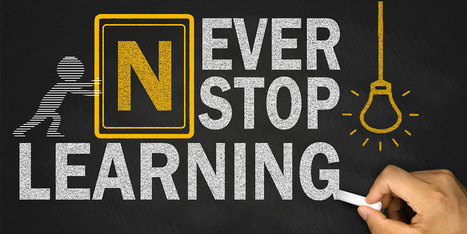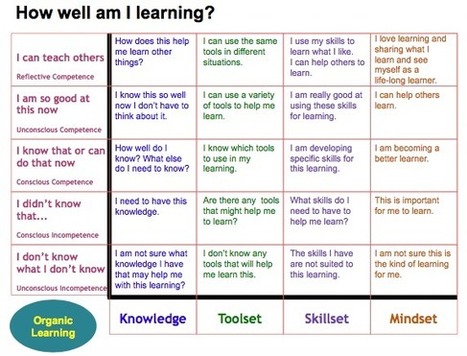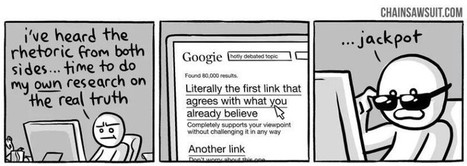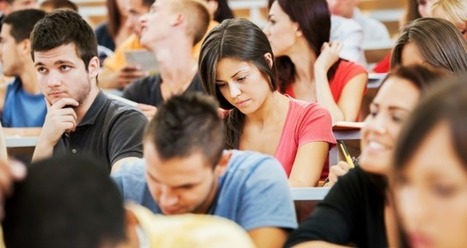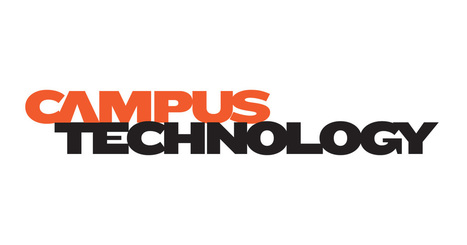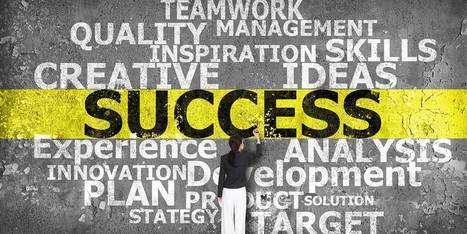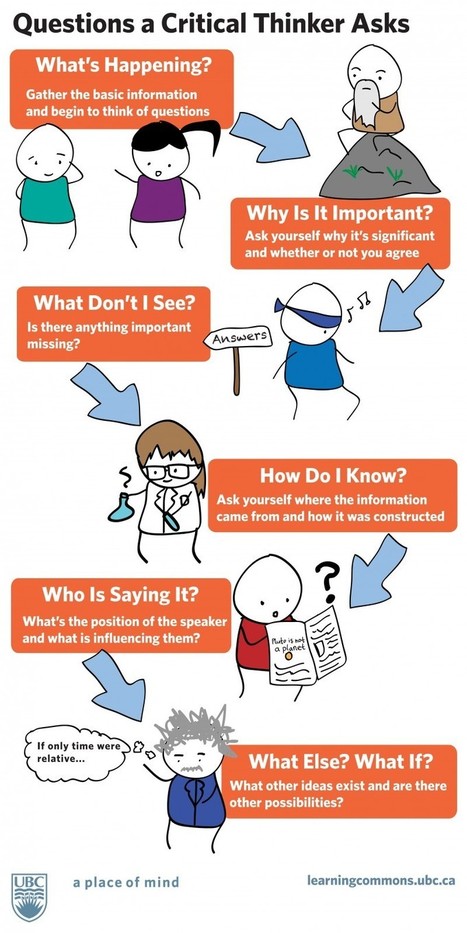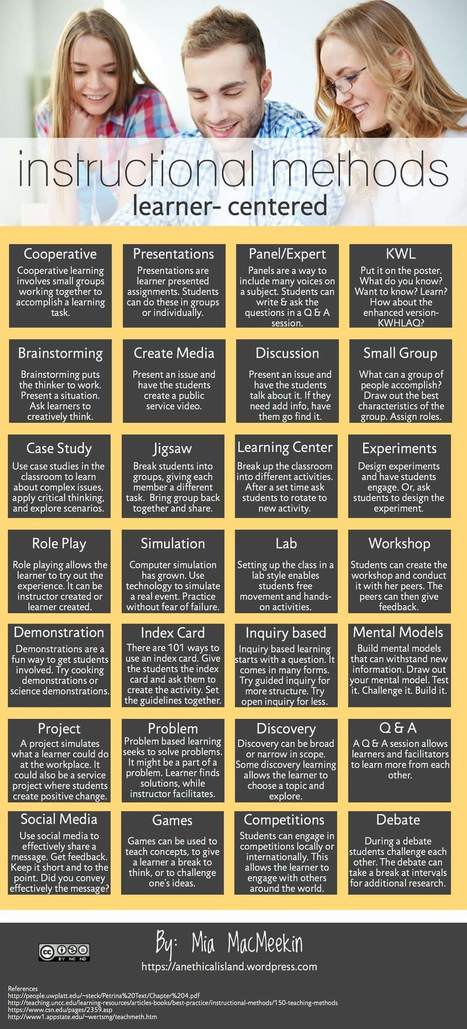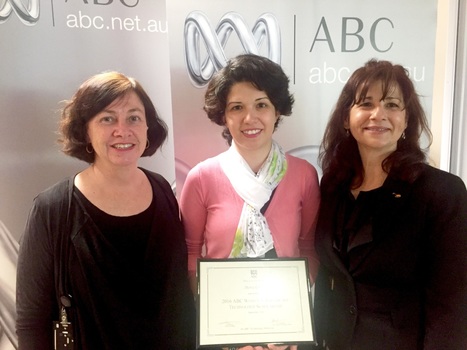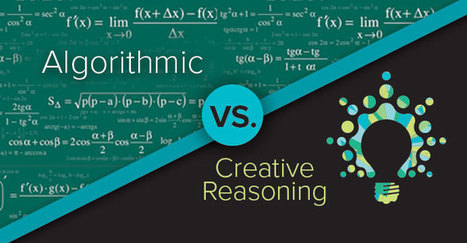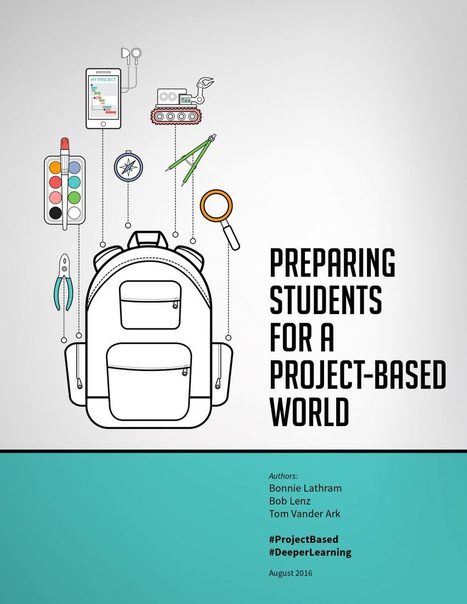 Your new post is loading...
 Your new post is loading...

|
Scooped by
Kim Flintoff
November 7, 2016 7:29 PM
|
Messy learning can be compared to a jumbled-up tangled string which meets itself several times at different angles. When you are forced to look at something at different angles, your perception is strengthened. Each angle reinforces your understanding of it.
Messy learning happens when we play unguided, forced to draw conclusions on our own. It also requires support from the teacher. Structure, templates, guiding questions, scaffolded skills, and the like—but it is in the honouring of the critical thinking process of which teachers need be aware. That’s because you cannot see it sometimes. It is virtually invisible. Like the dark matter of the universe, messy learning can be seen only by its effects upon the things around it.

|
Scooped by
Kim Flintoff
November 3, 2016 7:41 PM
|
Typically, teachers ask most questions in a classroom: about two every minutes. The quality of answers to these can only be so good, given the time for answers can be measured in seconds. What if students asked more questions of their own, and we gave them time to answer them? Might they be more invested in their inquiries, more keen to reveal an answer to a gap they have found for themselves?

|
Scooped by
Kim Flintoff
October 29, 2016 9:41 PM
|
An increasingly complex workplace
Organizations today face complicated circumstances — there’s a need to be sustainable; big data is on the rise; and there are privacy issues, political churn and economic volatility. But study after study has shown that CEOs and other executives don’t believe their employees hold the right core skills needed to handle these shifts.

|
Scooped by
Kim Flintoff
October 26, 2016 8:44 PM
|
HOLMAN’S READING LIST
For those interested in building metacognitive moments into the day, here are the articles Holman found to be useful and more or less reading-level appropriate for his high school students.
“From Degrading to De-Grading,” by Alfie Kohn
“Sermons For Grumpy Campers,” Richard Felder
“When Is a Good Day of Teaching a Bad Thing?,” by Timothy Slater
“Navigating the Bumpy Road to Student-Centered Instruction,” by Richard Felder
“Minimizing resistance to inquiry-oriented science instruction: The importance of climate setting,” by Carl J. Wenning
“Well, Duh!” — Ten Obvious Truths That We Shouldn’t Be Ignoring,” by Alfie Kohn
“Opinion: Why TEAL Works: 10 Years Ago MIT Had a Physics Problem. TEAL Fixed It,” by Ryan Normandin

|
Scooped by
Kim Flintoff
October 25, 2016 1:10 AM
|
Many people think that independence is the main goal of education. “Teach students so that they don’t need the teacher.” But what if that wasn’t the case? What if there were something higher than independence? Stephen Covey reminds us: Independent thinking alone is not suited to interdependent reality.
These are the stages that we want to lead our students through: dependence to independence to interdependence. If we can get them from dependence to independence, we’re almost there. Interdependence comes with applying their hard-earned skills toward relationship building.
How are we going to help our students develop independent thinking skills so that they may eventually use them in practicing interdependence?

|
Scooped by
Kim Flintoff
October 21, 2016 7:18 PM
|
Discover the power of change with this free case study
Teachers love stretching their students’ imaginations. Anna Russell, a Visual Arts teacher at Canberra’s Melrose High School, knows this well. Her idea to incorporate the 6Ds of Solution Fluency into her teaching was the perfect fit. So she turned to the Solution Fluency Activity Planner for her primary lesson planning tool.
Using Solution Fluency as a roadmap, Anna’s students embarked on a journey of discovering the true power of symbols in society. It was the groundwork for what would be some very rich and deeply insightful student design projects.
You can learn more about Anna and her amazing students in this case study. It's yours for free!

|
Scooped by
Kim Flintoff
October 13, 2016 11:45 PM
|
A recent study conducted by the Research and Analytics team at Colorado State University Online found that flipping the classroom may improve student participation and attendance rates. Flipping the classroom may also create a more challenging experience for learners and foster more critical thinking.
According to Sean Burns, assessment coordinator at CSU Online, flipped classrooms made students hold each other more accountable for showing up to class prepared. When implemented the wrong way, however, flipped classrooms created a very frustrating learning environment for students. “[The students] want goals and learning objectives defined for each class, and if this is missing, they feel lost and don’t get the maximum value from the class,” he said.

|
Scooped by
Kim Flintoff
October 11, 2016 2:55 AM
|
Whilst unpacking the idea of Conscious Competence and Skillset, Toolset, Mindset with teachers, we came to realise many of them were having difficulty applying these concepts to their own learning, beyond a superficial level (assumption one – not all teachers are reflective learners). We found this quite provocative and decided to create a visual on our Leadership Provocation Wall. Initially we attempted to combine Conscious Competence, SOLO and the Competency Set into one rubric, but ended up dropping SOLO as we struggled to align it with the other two. We expanded on our initial thinking and included Reflective Competence and Knowledge Set to our rubric. Our first attempt was critiqued over many months by various critical friends and we eventually came up with a workable prototype to use with teachers. Our first rubric focused on Professional Learning Inquiry for teachers. This worked so well we decided to create one for student learning and trialled it with our Stage 3 students (10-11 year olds). They picked it up quicker than the teachers (assumption two – don’t underestimate young learners!).

|
Scooped by
Kim Flintoff
October 6, 2016 8:13 PM
|
In A Shift to Active Learning Environments, colleges and universities are recognizing the benefits that shifting to an active learning environment can have on student outcomes—such as better grades, better retention of course material, and even better performance later on in the workplace.
Learn how institutions are transforming their learning environments to improve teaching:
Technology
Mobility
Creativity
Interactivity
Read this paper provided by Dell and Intel® to learn how your institution can successfully move to an active learning environment by completing the form to download the report today.

|
Scooped by
Kim Flintoff
September 29, 2016 12:40 AM
|
Have you ever wondered if your students are as concerned about their learning as you are? If you prioritize student learning, you may be the only person in your classroom with that goal. Learning-centered teachers seek to coauthor classroom experiences with their students, whereas students may seek only to be taught passively. How might you inspire your students to share accountability for their learning? These five considerations can help you teach your students to be learning centered, too.

|
Scooped by
Kim Flintoff
September 8, 2016 12:45 AM
|
One half of the entertainment duo Penn & Teller explains how performance and discomfort make education come alive.
Education, at its most engaging, is performance art. From the moment a teacher steps into the classroom, students look to him or her to set the tone and course of study for everyone, from the most enthusiastic to the most apathetic students. Even teachers who have moved away from the traditional lecture format, toward more learner autonomy-supportive approaches such as project-based and peer-to-peer learning, still need to engage students in the process, and serve as a vital conduit between learner and subject matter.
Teachers are seldom trained in the performance aspect of teaching, however, and given that every American classroom contains at least one bored, reluctant, or frustrated student, engagement through performance may just be the most important skill in a teacher’s bag of tricks.

|
Scooped by
Kim Flintoff
September 3, 2016 8:41 PM
|
Because thinking is hard.

|
Scooped by
Kim Flintoff
August 23, 2016 9:10 PM
|
As we continue our ongoing series focused on the flipped classroom in higher education, it’s time to tackle another frequently asked question: “How can I flip a large class?”
I like this question because it’s not asking whether you can flip a large class, but rather what’s the best way to do it. Faculty who teach large classes are challenged not only by the sheer number of students but also by the physical space in the classroom. Having 100, 200, or 400+ students in class means teaching in large lecture halls with stadium seating and seats that are bolted to the floor. It’s not exactly the ideal space for collaboration and group discussions, so the types of flipped and active learning strategies you can use are more limited.
Often, faculty fall back on the “think, pair, share” format or use clicker questions to encourage student engagement. But there are other techniques we can deploy in these large classrooms to engage students and involve them in higher levels of critical thinking and analysis.
To start the conversation, here are three strategies that work well in large lecture halls because they don’t require students to sit in groups or move around the room. Each of these strategies provides a framework for generating discussion, which increases engagement and encourages students to analyze a variety of perspectives. And if you aren’t teaching to the masses, these strategies can be easily modified for any class size.
|

|
Scooped by
Kim Flintoff
November 6, 2016 5:48 PM
|
The Vision
Jon Bergmann is one of the co-founders and pioneers of the flipped classroom. Jon has traveled the world speaking and training school leaders and educators in the flipped classroom model. He has seen first-hand the global promise, passion, and potential for flipped learning. He has also seen the pitfalls and myriad ways that flipped learning can be compromised by bad practice, inappropriate technology, and poor execution.
The Flipped learning Global Initiative was created to support the successful adoption and implementation of the flipped learning model around the world.
Flipped Learning Global Initiative
The mission of the Flipped Learning Global Initiative is to coordinate, orchestrate and scale the key elements required to successfully expand flipped learning internationally. FLGI is focused on identifying and developing strategic partnerships, initiatives, projects, best in class vendors, products, and services to introduce and support flipped learning around the globe. The Flipped Learning Global Initiative is led by Errol St.Clair Smith, Director of Global Development.

|
Scooped by
Kim Flintoff
November 2, 2016 7:39 PM
|
In a recent study, students learning via project tested better and improved applied problem-solving skills
Educators often talk about 21st-century skills and the benefits of incorporating communication, creativity, collaboration, problem-solving, and critical thinking into lessons. These are skills students rarely learn straight out of a textbook. The best way to teach them, we’ve found, is by making these skills a relevant part of their active lives.
If that sounds daunting, rest assured, it doesn’t always have to be. One way we have taught these skills is through project-based learning (PBL), where students apply what they’ve learned during a hands-on project that is relevant to the real world — and their lives.

|
Scooped by
Kim Flintoff
October 26, 2016 8:57 PM
|
Here are 5 ways to get to curate that practice by making your class a BYOD zone.
1. Accept Immediate Inquiry
2. Devices to aid in organizing and collaborating with peers
3. Keep ‘em engaged with real-time feedback
4. Document learning and thinking through blogging when the good ideas hit you!
5. Document and debrief field work with ease

|
Scooped by
Kim Flintoff
October 25, 2016 9:30 PM
|
The University of Wisconsin's (UWISC) first cohort of students to complete a significant number of their undergraduate courses primarily through the flipped classroom model is preparing to graduate in the spring.
The college has been encouraging its instructors to switch to a flipped classroom model, where students watch recorded video lectures before class and then use class time to put their learning into practice through in-class activities and to interact with their instructors and their classmates. According to a news release from the UWISC College of Engineering, the flipped learning approach can help students develop "communication and collaboration skills that often prove just as important as the technical foundations of engineering."

|
Scooped by
Kim Flintoff
October 25, 2016 1:10 AM
|
When workshopping project-based learning ideas, start by thinking about where you want to go and what you want to accomplish with your students. Although technology may play a huge role in how projects are put together, you want to keep it tangible. The Solution Fluency Activity Planner was built for project-based learning. It’s a guided system that makes PBL planning both easy and super-fun.

|
Scooped by
Kim Flintoff
October 14, 2016 11:35 PM
|
In the field of education, meanwhile, some people are trying to replace a system geared to memorizing facts and taking tests with one dedicated to exploring ideas. They’re committed to implementing a democratic, collaborative approach to schooling that learners will find more engaging than what they’re offered now. But those enamored of grit look at the same status quo and ask: How can we get kids to put up with it?
Duckworth acknowledges that it’s desirable for students to develop a long-term interest in what they’re doing, but the main thrust of her work is that “hard things” are worth doing just because they’re hard. Her goal is to figure out how to make students pay “attention to a teacher rather than daydreaming” and “behav[e] properly in class.” And in her more recent research, she even created a task that’s deliberately boring, the point being to find strategies for resisting the temptation to do something more appealing instead.
Whether that uninteresting stuff is worth doing apparently doesn’t matter. As long as kids keep at it.

|
Scooped by
Kim Flintoff
October 11, 2016 2:56 AM
|
In an earlier post here in Educational Technology and Mobile Learning I talked about the 8 elements of the critical thinking process and I argued that critical thinking is a cognitive process that requires disruptive patterns of thinking, ones that question the status quo of propositions and leads to the creation of alternative lines of reasoning.
Today I am adding to this discussion this beautiful visual created by Learningcommons which features the 6 questions a critical thinker asks. This could be used as a poster in your classroom to remind students of the kind of questions they need to ponder about and develop. Have a look and share with your colleagues.

|
Scooped by
Kim Flintoff
October 6, 2016 8:30 PM
|
For in-person professional development from TeachThought on effective instructional strategies or any other topic your school or district might need, contact us today.
Student-centered teaching is teaching designed for the student. This means that planning often begins with the student in mind as opposed to a school policy or curriculum artifact, for example. Done well, it can disarm some of the more intimidating parts of academia, while also shortening the distance between the student and understanding.

|
Scooped by
Kim Flintoff
October 4, 2016 1:05 AM
|
CURTIN University student Mona Ghiasi was named the recipient of the ABC Women in Broadcast Technology Scholarship for Western Australia.
Ms Ghiasi received four weeks paid work experience with the national broadcaster’s technology team in Perth.
She will experience first-hand the technical side of broadcasting; how the equipment works, how radio and television are transmitted and how to keep programs on air when things go wrong.

|
Scooped by
Kim Flintoff
September 26, 2016 7:31 PM
|
Neuroscience proves what effective educators have known all along.
In some instances, research illuminates a topic and changes our existing beliefs. For example, here’s a post that challenges the myth of preferred learning styles. Other times, you might hear about a study and say, “Well, of course that’s true!” This might be one of those moments.
Last year, Dr. Karlsson Wirebring and fellow researchers published a study that supports what many educators and parents have already suspected: students learn better when they figure things out on their own, as compared to being told what to do.

|
Scooped by
Kim Flintoff
September 7, 2016 2:57 AM
|
Best Creative Engagement Strategy
(Mr Rohan McDougall, Curtin University (left), Dr Alastair Hick, KCA (right))
Cisco Internet of Everything Innovation Centre – Curtin University
The Cisco Internet of Everything Innovation Centre, co-founded by Cisco, Curtin University and Woodside Energy Ltd, is a new industry and research collaboration centre designed to foster co-innovation. With a foundation in radioastronomy, supercomputing and software expertise, it is growing a state-of-the-art connected community focused on leveraging data analytics, cybersecurity and digital transformation network platforms to solve industry problems. The Centre combines start-ups, small–medium enterprises, industry experts, developers and researchers in a collaborative open environment to encourage experimentation, innovation and development through brainstorming, workshops, proof-of-concept and rapid prototyping. By accelerating innovation in next-generation technologies, it aims to help Australian businesses thrive in this age of digital disruption.

|
Scooped by
Kim Flintoff
August 28, 2016 8:52 PM
|
In the paper, Preparing Students for a Project-Based World, released jointly by Getting Smart and Buck Institute for Education (BIE), we explore equity, economic realities, student engagement and instructional and school design in the preparation of all students for college, career and citizenship.
Featuring blogs, podcasts and videos with students, teachers and leaders in the United States and internationally, as well as insights from people in the business community, this publication makes the case for high-quality project-based learning (PBL) as a way to optimally prepare students for the project-based world they are inheriting by exploring:
The New Economy: Project-based learning prepares students for a competitive, project-based and global economy.
- Equity: Preparing students for a project-based economy a social justice issue.
- Myths and Misconceptions: Myths about the implementation of high-quality project-based learning.
- Recommendations: A project-based economy has implications for students, teachers and leaders. We shine a light on best practices and models to prepare students for college, career and citizenship and illuminate the path forward.
We have also released a quick start guide for students that gives tools and best practices for project-based learning at school and outside of it.
|

 Your new post is loading...
Your new post is loading...
 Your new post is loading...
Your new post is loading...




